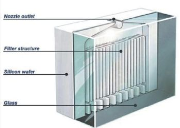 Ireland’s medical technology sector has evolved into one of the leading clusters for medical device and diagnostic products globally. Now, these companies are adopting industrial vision systems, such as those offered by Stemmer Imaging, to reduce waste, improve quality and productivity and optimise energy usage leading to better competitiveness
Ireland’s medical technology sector has evolved into one of the leading clusters for medical device and diagnostic products globally. Now, these companies are adopting industrial vision systems, such as those offered by Stemmer Imaging, to reduce waste, improve quality and productivity and optimise energy usage leading to better competitiveness
According to the Irish Medical Device Association, around 160 companies export €6.8b worth of product annually and employ 24,000 people. The industry is involved in developing, manufacturing and marketing a range of products and services from disposable plastic and wound care products to precision metal implants including pacemakers, microelectronic devices, orthopaedic implants, diagnostics, contact lenses and stents. Against this background, the industry is constantly looking for new ways to enhance competitiveness, develop new capabilities and generate new sustainable growth.
Industrial vision systems are not only used directly to help with the automation of processes, provide an inspection capability for quality control or an input for statistical process control, but can also work in tandem with robotics. Inspection of medical devices for defects as part of the quality control process is an important application of industrial vision, since any defects could potentially lead to a health risk in patients.
 High resolution imaging
High resolution imaging
Many medical devices feature very small components that need to be inspected. A manufacturer of drug delivery devices developed a new generation of drug inhalers, which does not use a propellant gas. The inhaler’s core component consists of an innovative nozzle which generates a fine diffuse spray. The active solution is forced through a microstructured filter system in the nozzle. This results in two spray jets which meet one another at a defined angle and generate the unique diffuse cloud of spray. The filter system in the nozzle (Figure 1) consists of silicon and bonded glass. The microscopic structures in the silicon have a depth of 6µm and a minimum width of 2µm. The inspection system recognises bond defects which result in the contamination of the channels, bond defects on the external surfaces and the presence of particles inside the component. It also checks for structure integrity and verifies the external dimensions. It features three different cameras, and seven, polsed ultrabright LED modules to provide the illumination via fibre optics (Figure 2). Using special lenses, this high resolution imaging system provides a field of view of 2 x 2mm and an optical resolution of 500nm at a distance of 15mm from the object, which makes it possible to reliably identify defects of approximately 2µm.
 Seeing things in the right light
Seeing things in the right light
Another application highlights the importance of the selection of the correct illumination methods for inspection. A manufacturer of pharmaceutical and medical devices, needed to inspect an internal plastic gear, smaller than a thumbnail, used in a particular drug delivery device. The inspection procedure, traditionally carried out mechanically, required a check for both the presence of each gear tooth, as well as the gear itself. The objective of switching to a vision system was to improve quality, speed up the process and reduce cost. The major problem, however, was that the gear itself was white and mounted against a white background. A smart camera equipped with a polarising filter on the lens, and an additional polarising filter on the light source was used. By tuning the two filters to the right position, an image in which the gear stood out from the background, was generated (Figure 3).
Understanding the application
The case studies illustrate some of the facets that go to make up a vision system and how important is the selection of every component to ensure the required end result is achieved. Stemmer Imaging’s capabilities extend beyond the product line-up of several thousand imaging products from leading manufacturers. By working in partnership with customers, a tested and validated solution can be produced to solve the particular imaging task.


